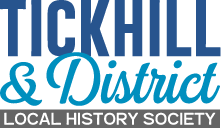

Tickhill’s Migrant Population: an 1881 Case-study
In the later part of the 19th Century Tickhill’s population certainly included many people who were born here, but it also had three specific types of ‘incomers’ as shown in the 1881 Census Returns. The most affluent families (whose wealth derived from land rents and investments) and their households contained people who were born far from this area as in these two examples. In 1881 Joshua and Alice Jebb, born respectively near Birmingham and in Midlothian, along with their two sons and two daughters, aged one to seven and all born in nearby Blyth, were looked after by nine servants in their Northgate home. The list shows the types of servants and their place of birth:
- Governess (Tottenham)
- Butler (Canterbury)
- Nurse (Ipswich)
- Cook (Norfolk)
- Housemaid (Lincolnshire)
- Kitchenmaid Northampton)
- Nursemaid (Lincolnshire)
- Groom (Maltby)
- Page Boy (Nottingham)
The Leather family at the Friary consisted of Frederick and Gertrude Leather, born respectively in Derbyshire and Hampshire, their three daughters aged eight to sixteen, born in Gloucestershire, Surrey and Yorkshire, and two sons aged one and two born in Tickhill. They also had a large household:
- Governess ( Fulham)
- Serving Maid (Lincolnshire)
- Cook (Lincoln)
- Waiting Maid (Huntingdon)
- Housemaid (Durham)
- Nurse (Lincolnshire)
- Nursery Maid (Doncaster)
- Kitchenmaid (Tickhill)
The servant born furthest away was Mary Smith, born in India, a nurse in the Lindrick household of Reginald Hall, Captain in the 2nd Derby Militia.
A second group of ‘incomers’ were women who married Tickhill-born men. Some moved relatively short distances from their place of birth like Charlotte Clarkson, wife of George Clarkson, born in Stainforth, Mary Colbeck, wife of George Colbeck, born in Sheffield and Amelia Fullwood, wife of Francis Fullwood, born in Finningley. Others were born much further away like Clara Gleadall, wife of George Gleadall, born in London, Louisa Lye, wife of George Lye, born in Maidstone and Elizabeth Whinfrey, wife of Thomas Whinfrey, born in Salisbury.
A third category were families and individuals who moved to Tickhill for work in farming, trades or other professions. In Folds Farm, for example, the widowed Sophia Thompson, was responsible for a farm of 250 acres. She was born in Worcester and her four children living at home aged twenty to twenty-nine were all born at Sykehouse. Galley Hill Farm was the home of George Chester, a bailiff, and his wife Sarah. They were born at Awkley and Mansfield respectively, their two eldest children aged fifteen and twenty-one were born at Stancil and four youngest children, aged four to thirteen, were born in Tickhill. Sometimes unmarried men working as agricultural labourers lodged with families after they left home. Robert Bennett, born in Suffolk, lodged with the Stables family in Westgate, where William Stables, head of the family, was also an agricultural labourer. Most of the licensed victuallers and some of the grocers, bakers and butchers were not Tickhill-born people. Among the unmarried men living as lodgers and undertaking trades was Samuel James, a painter, born in South Africa. More usually these lodgers had been born in nearby towns or counties. All of the men working as clergy, and in the civil service, education, legal and medical professions had moved to Tickhill. Some such as Irish-born Maurice Woulfe, an officer with the Inland Revenue and Welsh-born surgeon George Phillips, were far from their birth-places. Others, such as schoolmaster Thomas Dixon lodging in Northgate, were at least in the county of their birth.
There were two areas of Tickhill where people not born locally could also be found: the ‘common lodgings’ on Sunderland Street home to a variety of employed and unemployed labourers, mainly from midland counties, but three men came from further afield, Ireland and France. The second area was Westgate where caravans were parked housing families who travelled around the Midlands, their travels marked by the birth-places of the children.
Migration patterns not only reflected movement into Tickhill. The 1881 Census lists too a whole range of Tickhill-born people who had migrated elsewhere. That, as they say, is another story except to record the family of Tickhill-born John and Catherine Gleadall whose three eldest children were born in Canada and whose four youngest children aged one to six were born in Tickhill, suggesting that the Gleadalls were among the thousands of British ‘back’ migrants in the 19th Century.
Migration patterns not only reflected movement into Tickhill. The 1881 Census lists too a whole range of Tickhill-born people who had migrated elsewhere. That, as they say, is another story except to record the family of Tickhill-born John and Catherine Gleadall whose three eldest children were born in Canada and whose four youngest children aged one to six were born in Tickhill, suggesting that the Gleadalls were among the thousands of British ‘back’ migrants in the 19th Century.